List of butterflies of India (Papilionidae)
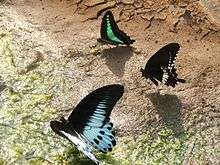
blue Mormon (Papilio polymnestor), common Mormon (Papilio polytes) and common bluebottle (Graphium sarpedon). (left to right anticlockwise)

This is a list of the butterflies of family Papilionidae, or the swallowtails, which are found in India. This family of large and beautiful butterflies is well represented with about 84 species found within Indian borders, the exact number depending on the taxonomy followed.[1][2]
Two of the three papilionid subfamilies are represented in India, namely, the Parnassiinae or Apollos, with 14 species, and the Papilioninae or swallowtails, with 70 species.
Diversity of Indian swallowtails
Indian swallowtails are found almost everywhere in the country. The Malabar banded peacock (Papilio buddha) and the Malabar banded swallowtail (Papilio liomedon) fly at sea level while the Apollos (Parnassius species), are to be found only in the highest alpine meadows of the Himalayas. Some species such as the common Mormon (Papilio polytes) and the blue Mormon (Papilio polymnestor) fly at ground level whereas others, such as the tailed jay (Graphium agamemnon) are normally found flying high in the forest canopy. The lime butterfly (Papilio demoleus) is a creature of arid scrub-land, occasionally being spotted even in the Thar Desert, while the tropical evergreen forests have their own representatives, such as the red Helen (Papilio helenus), the common bluebottle (Graphium cloanthus) and the Malabar raven (Papilio dravidarum).[3] Indian papilionids such as the common Mormon (Papilio polytes) and great Mormon (Papilio memnon) show polymorphism with many mimetic female forms.[4][5]
While spread over all the biogeographic zones of India, amongst swallowtails, endemism is found only in the Western Ghats. Notable endemics are the southern birdwing (Troides minos), Malabar banded swallowtail (Papilio liomedon), Malabar raven (Papilio dravidarum), Malabar rose (Pachliopta pandiyana) and the Malabar banded peacock (Papilio buddha).[6]
Checklist
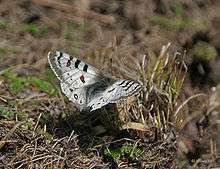
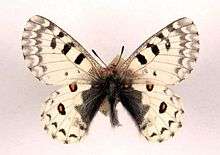

The subgenus, where applicable, is given as an additional epithet in parentheses in between the genus and species epithets in the scientific name.
Subfamily Parnassiinae
The Apollos, Parnassius are different in appearance from other swallowtails, being of moderate size, with white ground colour, spotted with red, black and blue.
Tribe Zerynthiini
Bhutanitis - Bhutan glory
- Bhutan glory, Bhutanitis lidderdalii Atkinson, 1873[7]
Tribe Parnasiini
Parnassius - Apollos
- Maharaja Apollo, Parnassius maharaja Avinoff, 1913
- Karakoram banded Apollo, Parnassius staudingeri hunza Grumm-Grshimailo, 1888*
- Ladakh banded Apollo, Parnassius stoliczkanus C. & R. Felder, 1865
- Parnassius acdestis, Parnassius acdestis Oberthür, 1883*
- Imperial Apollo, Parnassius imperator augustus Oberthür, 1883
- Regal Apollo, Parnassius charltonius (Gray, 1853)
- Varnished Apollo, Parnassius acco Gray, 1852
- Hannyngton's Apollo, Parnassius hannyngtoni (Avinoff, 1916)
- Black-edged Apollo, Parnassius simo (Gray, 1853)
- Common blue Apollo, Parnassius hardwickii (Gray, 1831)
- Keeled Apollo, Parnassius jacquemontii (Boisduval, 1836)
- Common red Apollo, Parnassius epaphus (Oberthür, 1879)
- Parnassius actius (Eversmann, 1843)
- Large keeled Apollo, Parnassius tianschianicus (Oberthür, 1879)
- Nanda devi Apollo, Parnassius nandadevinensis Weiss, 1990
Subfamily Papilioninae


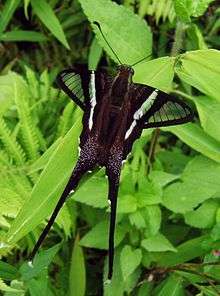
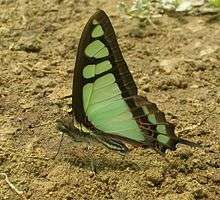
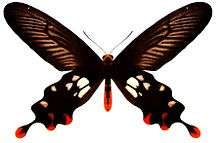
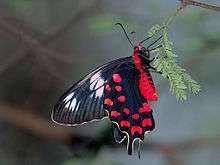
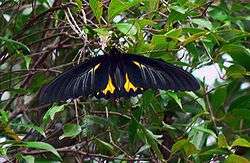

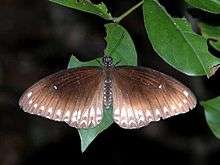

The swallowtails are generally easily identified in the field by their large size, prominent markings, colour, patterns and variable wing and tail shape.
Tribe Troidini
Losaria (formerly Atrophaneura) - clubtails
- Common clubtail, Losaria coon (Fabricius, 1793)[7]
- Andaman clubtail, Losaria rhodifer (Butler, 1876)[7]
Pachliopta (formerly Atrophaneura) - roses
- Crimson rose, Pachliopta hector (Linnaeus, 1758)
- Malabar rose, Pachliopta pandiyana (Moore, 1881)
- Common rose, Pachliopta aristolochiae (Fabricius, 1775)
Troides - birdwings
- Common birdwing, Troides helena (Linnaeus, 1758)
- Southern birdwing, Troides minos (Cramer, 1779)
- Golden birdwing, Troides aeacus (C. & R. Felder, 1860)
Atrophaneura (Atrophaneura) - red-bodied swallowtails
- Lesser batwing, Atrophaneura aidoneus (Doubleday, 1845)
- Common batwing, Atrophaneura varuna (A. White, 1868)[8]
Byasa (formerly Atrophaneura) - windmills
- Rose windmill, Byasa latreillei (Donovan, 1826)
- De Nicéville's windmill, Byasa polla (de Nicéville, 1897)
- Neville's windmill, Byasa nevilli (Wood-Mason, 1882)
- Common windmill, Byasa polyeuctes (Doubleday, 1842)
- Great windmill, Byasa dasarada (Moore, 1858)
- Black windmill, Byasa crassipes (Oberthür, 1893)
- Pemberton's windmill or Tytler's windmill, Byasa plutonius (Oberthür, 1876)
Tribe Papilionini
- Tawny mime, Papilio agestor Gray, 1831
- Lesser mime, Papilio epycides Hewitson, 1864
- Blue striped mime, Papilio slateri Hewitson, 1859
- Great blue mime, Papilio paradoxa (Zinken-Sommer, 1831)
- Common mime, Papilio clytia, Linnaeus, 1758
- Blue Mormon, Papilio polymnestor (Cramer, 1775)
- Great Mormon, Papilio memnon (Linnaeus, 1758)
- Andaman Mormon, Papilio mayo (Atkinson, 1873)
- Tailed redbreast, Papilio bootes (Westwood, 1842)
- Redbreast, Papilio alcmenor (C. & R. Felder, 1864)
- Spangle, Papilio protenor (Cramer, 1775)
- Yellow-crested spangle, Papilio elephenor (Doubleday, 1845)
- Chinese peacock, Papilio bianor Cramer, 1777
- Paris peacock, Papilio paris (Linnaeus, 1758)
- Blue peacock, Papilio arcturus (Westwood, 1842)
- Krishna peacock, Papilio krishna (Moore, 1857)
- Common banded peacock, Papilio crino (Fabricius, 1792)
- Malabar banded peacock, Papilio buddha (Westwood, 1872)
- Malabar raven, Papilio dravidarum (Wood-Mason, 1880)
- Common raven, Papilio castor (Westwood, 1842)
- Red Helen, Papilio helenus (Linnaeus, 1758)
- Yellow Helen, Papilio nephelus (Boisduval, 1836)
- Andaman Helen, Papilio prexaspes andamanicus (Goeze, 1779)
- Common Mormon, Papilio polytes (Linnaeus, 1758)
- Malabar banded swallowtail, Papilio liomedon (Moore, 1874)
- Lime butterfly, Papilio demoleus (Linnaeus, 1758)
- Common yellow swallowtail, Papilio machaon (Linnaeus, 1758)
Tribe Leptocircini
Lamproptera - dragontails
- Green dragontail, Lamproptera meges (Zinken-Sommer, 1831)
- White dragontail, Lamproptera curius (Fabricius, 1787)
Graphium (Graphium) - bluebottles and jays
- Tailed jay, Graphium (Graphium) agamemnon (Linnaeus, 1758)[7]
- Spotted jay, Graphium (Graphium) arycles (Boisduval, 1836)[7]
- Veined jay, Graphium (Graphium) chiron (Wallace, 1865)[7]
- Glassy bluebottle, Graphium (Graphium) cloanthus Westwood, 1841[7]
- Common jay, Graphium (Graphium) doson (C. Felder & R. Felder, 1864)[7]
- Great jay, Graphium (Graphium) eurypylus (Linnaeus, 1758)[7]
- Lesser jay, Graphium (Graphium) evemon (Boisduval, 1836)[7]
- Common bluebottle, Graphium (Graphium) sarpedon (Linnaeus, 1758)[7]
Graphium (Paranticopsis) - zebras
- Great zebra, Graphium (Paranticopsis) xenocles (Doubleday, 1842)[7] (= leucothoe Westwood)
- Lesser zebra, Graphium (Paranticopsis) macareus (Godart, 1819)[7]
- Spotted zebra, Graphium (Paranticopsis) megarus (Westwood, 1841)[7]
Graphium (Pathysa) - swordtails
- Fourbar swordtail, Graphium (Pathysa) agetes (Westwood, 1841)[7]
- Fivebar swordtail, Graphium (Pathysa) antiphates (Cramer, [1775])[7]
- Chain swordtail, Graphium (Pathysa) aristeus (Stoll, 1780)[7]
- Andaman swordtail, Graphium (Pathysa) epaminondas, Oberthür, 1879[7]
- Spot swordtail, Graphium (Pathysa) nomius (Esper, 1798)[7]
Graphium (Pazala) - swordtails
- Sixbar swordtail, Graphium (Pazala) eurous (Leech, 1893)[7]
- Spectacle swordtail, Graphium (Pazala) mandarinus (Oberthür, 1879)[7] (= glycerion Gray)
Tribe Teinopalpini
Meandrusa - hooked swallowtails
- Brown gorgon, Meandrusa sciron (Leech, 1890)
- Yellow gorgon, Meandrusa payeni (Boisduval, 1836)
Teinopalpus - Kaiser-e-Hind
- Kaiser-e-Hind, Teinopalpus imperialis (Hope, 1843)
See also
Cited references
- ↑ Evans (1932) states, in a table on pg 23, the number of papilionids in the Indian subcontinent as 90; 15 species being found in Ceylon, 19 in South India, 6 in Baluchistan, 11 in Chitral, 31 in the Western Himalayas, 69 in Northeast India, 50 in Southern Burma and 13 in the Andaman and Nicobar islands. Wynter-Blyth (1957) gives a modified version of the same table on p. 12, where the overall number of species is 94; with differences being in total number of species for Northeast Himalayas (62) and Burma (66). The present list is based on the IUCN red data book, with corrections made by subsequent editors especially in the Parnassiinae.
- ↑ Kunte (2000) on p. 55 mentions a total of 107 species with 19 in peninsular India.
- ↑ Kunte, Krushnamegh (2000). Butterflies of Peninsular India. India, A Lifescape. Hyderabad, India: Universities Press. pp. 55–58, chapter 5.1. ISBN 978-8173713545.
- ↑ Clarke, C.A.; Sheppard, P.M. & Thornton, I.W.B. The Genetics of the Mimetic Butterfly Papilio memnon L. Philosophical Transactions of the Royal Society, London. (B - Biological Sciences) 22 August 1968 vol. 254 no. 791 37-89. Abstract. Accessed on 20 Jan 2010.
- ↑ Clarke, C.A. & Sheppard, P.M. The Genetics of the Mimetic Butterfly Papilio polytes L. Philosophical Transactions of the Royal Society, London. (Series B, Biological Sciences) Vol. 263, No. 855 (16 Mar. 1972), pp. 431-458. Abstract. Accessed on 20 Jan 2010.
- ↑ Kehimkar, Isaac (2009). The Book of Indian Butterflies. Mumbai: Bombay Natural History Society. p. 38; 497. ISBN 978-0-19-569620-2. Retrieved 21 October 2010.
- 1 2 3 4 5 6 7 8 9 10 11 12 13 14 15 16 17 18 19 20 21 Scientific names all corrected as per Häuser, Christoph L.; de Jong, Rienk; Lamas, Gerardo; Robbins, Robert K.; Smith, Campbell; Vane-Wright, Richard I. (28 July 2005). "Papilionidae – revised GloBIS/GART species checklist (2nd draft)". Retrieved 8 November 2010.
- ↑ White, A. (1842): Notice of two New Species of Papilio from Penang, presented to the British Museum by Sir Wm. Norris. - The Entomologist 1 (17), pp. 280..
References

- Chattopadhyay, Jagannath. (2007) "Swallowtail Butterflies, Biology and Ecology of a few Indian Species." Desh Prakashan, Kolkata, West Bengal, India. ISBN 978-81-905719-1-3.
- Collins, N. Mark; Morris, Michael G. (1985). Threatened Swallowtail Butterflies of the World: The IUCN Red Data Book. Gland & Cambridge: IUCN. ISBN 978-2-88032-603-6.
- Evans, W.H. (1932). The Identification of Indian Butterflies (2nd ed.). Mumbai, India: Bombay Natural History Society.
- Gay, Thomas; Kehimkar, Isaac David; Punetha, Jagdish Chandra (1992). Common Butterflies of India. Nature Guides. Bombay, India: World Wide Fund for Nature-India by Oxford University Press. ISBN 978-0195631647.
- Haribal, Meena (1992). The Butterflies of Sikkim Himalaya and Their Natural History. Gangtok, Sikkim, India: Sikkim Nature Conservation Foundation.
- Kunte, Krushnamegh (2000). Butterflies of Peninsular India. India, A Lifescape. Hyderabad, India: Universities Press. ISBN 978-8173713545.
- Wynter-Blyth, Mark Alexander (1957). Butterflies of the Indian Region. Bombay, India: Bombay Natural History Society. ISBN 978-8170192329.

